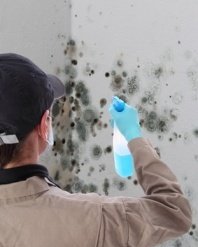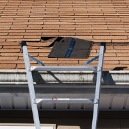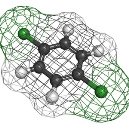Find a pre-screened local mold removal specialist Free Estimate
Find a Mold Specialist Now
Click or Call, Toll-Free 24/7
Removing Mold - Products To Use
If you’re interested in removing mold yourself and want to know what products to use, you’ve come to the right place. We’ll tell you about a variety of products used to remove mold, as well as products used to encapsulate mold, and let you know the pros and cons of each. We’ll also give you our recommendations for the most effective products to use.
Before tacking any mold removal project yourself, we recommend you have a professional inspect your property to make sure the job isn’t larger or more complex than you think. It’s not always easy to find hidden mold. Most mold removal companies will give a free inspection and evaluation, so it won’t cost you anything. You can follow this link to get a list of local mold removal companies that will come to your home and give you a free evaluation.
Products For Removing Mold
Bleach
Bleach can be used to remove most types of household mold, provided the mold is growing on non-porous surfaces, such as tile, tubs, sinks, glass, and countertops. Bleach will not be effective against mold growing on porous surfaces like wood or drywall, because mold spores can get inside the microscopic openings in these materials and bleach will not penetrate deeply enough to kill all of the mold.
To use bleach to remove mold from non-porous surfaces, use mix one cup of bleach in one gallon of water. Use a spray bottle to apply solution to the moldy surface or simply apply with a rag. Make sure the area in which you are working is well-ventilated, since the fumes from chlorine bleach can be harmful.
Vinegar
Some people use vinegar to try to remove mold, but this is not a very effective method of mold removal. Vinegar is acidic and can kill about 82% of all types of mold. That means in almost 20% of cases, it won’t get rid of the mold. However, it is cheap, readily available, non-toxic, and has no harmful fumes, so some people prefer to try it before using stronger products.
To remove mold with vinegar, pour vinegar into a spray bottle. Don’t dilute it with water. Spray the vinegar on the moldy surface, let it sit for about an hour, then wipe off mold with a rag.
Bathroom Cleansers
Some bathroom cleansers are designed to kill mold on bathroom surfaces like tubs, sinks, and tile. These cleansers often contain chlorine bleach, so plain old bleach and water might be just as effective. However, using these cleansers as directed on the product labels will generally be effective on non-porous surfaces. Make sure to use them as directed and only in well-ventilated areas.
Tea Tree Oil
Tea tree oil is an essential oil made from a plant called Melaleuca Alternifolia. It’s used by some people to treat infections and fungi, and it will kill most types of mold. To use tea tree oil to remove mold, mix one teaspoon of tea tree oil with one cup of water in a spray bottle. Spray the moldy area thoroughly, then scrub the area with a damp cloth.
One problem with using tea tree oil to remove mold is that it can be expensive. You can buy a half-ounce bottle of tea tree oil at many health food stores for about $10. Half an ounce of tea tree oil is three teaspoons, enough to make three cups of mold remover. If you have only a small area of mold to remove, that will do the job. If you have a large area of mold to remove, you’ll need to buy a lot of tea tree oil.
Another problem with tea tree oil is that it may not be effective on porous surfaces, like wood or drywall.
Foster 40-80 Disinfectant
This is an all-in-one disinfectant, fungicide, virucide, and germicide. It’s EPA registered and effective against a wide range of microbes, including mold. It can be used on porous, semi-porous, and non-porous surfaces, although it is not always possible to clean porous materials thoroughly and they may need to be removed and replaced, instead. Consult with a mold remediation professional if you’re not sure if specific materials can be saved, and if in doubt, throw it out and replace it to be safe. Here is a link to Foster 40-80 on Amazon.com.
Encapsulating Mold – Products to Use
When mold is growing on a porous surface and the material cannot be removed, for instance on wooden studs inside a wall, encapsulating the area may be necessary. First, as much mold as possible is removed from the surface and the surface is cleaned with a fungicide like Foster 40-80. Then, an encapsulating product is painted over the surface to seal in any remaining mold.
Paint
Never paint over wooden surfaces, drywall, or other materials if you’re not absolutely certain all traces of mold have been removed. Paint can hide remaining traces of mold and make it more difficult to see if mold is beginning to grow back, but it won’t prevent mold from continuing to grow and spread. Paint cannot be used to encapsulate mold.
Follow this link for more information on using mold resistant paint.
Foster 40-50 Mold Resistant Coating
This coating is applied with a paintbrush or roller and can be used on many different surfaces, including wood, drywall, masonry, and metal. It contains EPA registered antimicrobial agents that inhibit the growth of mold and bacteria. Be sure to read and follow all instructions on the product package. It is available on Amazon.com.
Learn when to encapsulate mold, and the risks involved.
For More Information
For more information about products for removing mold, as well as the safest and most effective mold removal techniques, we recommend the ebook A Homeowner’s Complete Guide to Mold Remediation by Brian Turner. Follow the link to learn more about this book.
Additional Reading:
To read more about mold removal products, follow the link.
Return From Products For Removing Mold To Home Page
Free Home Inspection By A Mold Removal Specialist
Search This Website

Recent Articles
-
See Our 5 Recommended Mold Removal Companies in Wheaton, IL
Jun 20, 24 10:33 AM
-
See Our 5 Recommended Mold Removal Companies in Aberdeen, SD
Oct 08, 21 04:05 PM
-
Public Housing Tenant Sick from Mold
Apr 24, 20 01:40 PM



